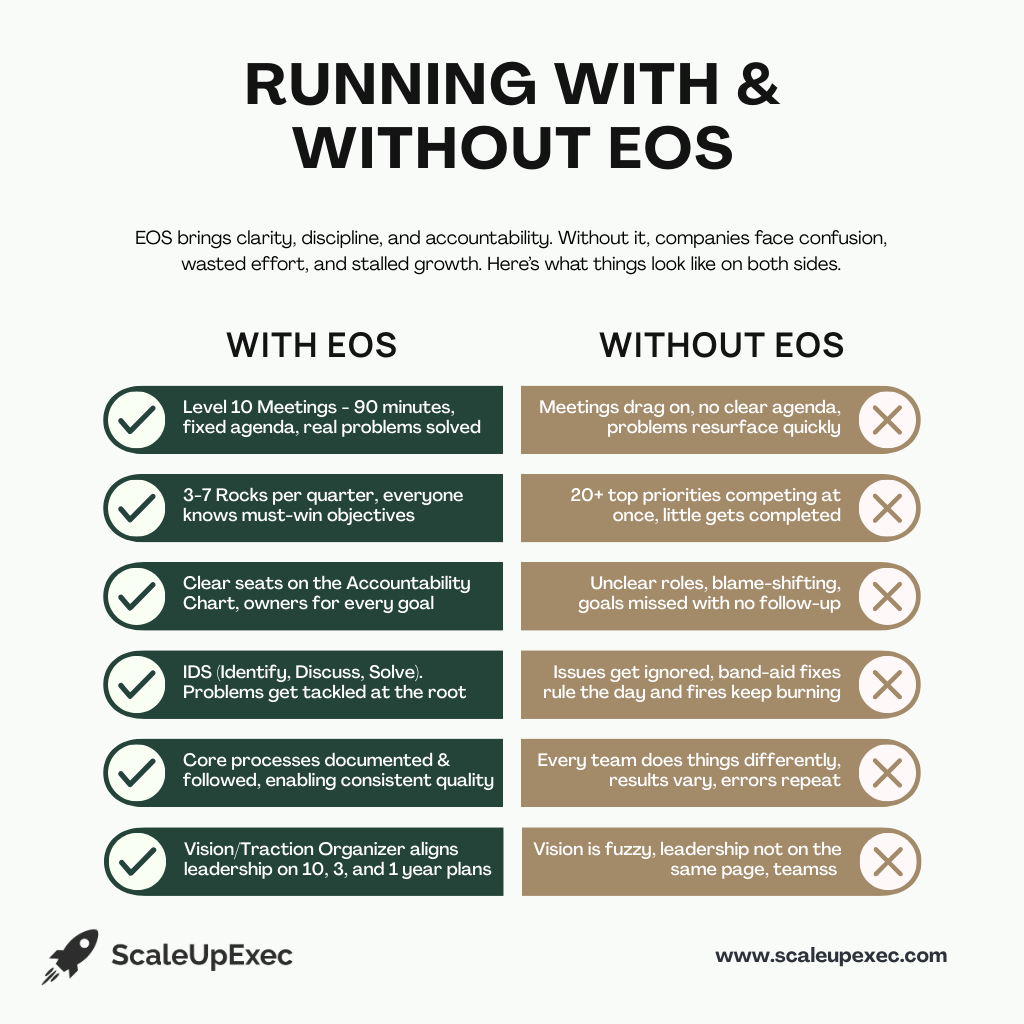EOS stands for the Entrepreneurial Operating System. It’s a framework that helps companies get organized, improve leadership, and grow in a healthy way. EOS is not a piece of software. It’s a system of tools, habits, and processes that guide how a company operates every day.
When a company runs on EOS, it means they are using this framework to manage goals, solve problems, and maintain accountability. Everything from leadership meetings to long-term vision planning follows a clear structure. The goal is to create a business that runs smoothly with less stress and more results.
Core Principles of EOS
EOS focuses on six key parts of a business: Vision, People, Data, Issues, Process, and Traction. Each of these areas works together to create balance and control. The system helps leadership teams get on the same page about where the company is going and how to get there.
Vision
EOS ensures everyone in the company knows where the business is headed. Leadership teams set a 10-year target, a 3-year picture, and a 1-year plan. That clarity eliminates conflicting agendas and channels energy toward the same goals.
People
The right structure means little without the right team. EOS emphasizes putting the right people in the right seats—building a leadership bench that can actually deliver on the company’s vision.
Data
Running on EOS means running on facts, not gut feelings. Scorecards with 5–15 weekly numbers give leaders a quick, honest read on business health. Problems get spotted early and corrected before they grow.
Issues
Every company has issues. EOS provides a simple process—Identify, Discuss, Solve (IDS)—to address them at the root. Instead of recycling problems week after week, teams resolve them and move forward.
Process
Companies scale when their core processes are clear and consistent. EOS pushes leaders to document the 20% of processes that drive 80% of results and make sure everyone follows them. This consistency reduces errors and keeps quality high.
Traction
Execution is where most visions fall apart. EOS brings discipline through Rocks (90-day priorities) and Level 10 Meetings (weekly leadership check-ins). This cadence ensures strategy translates into consistent results.
For example, the Vision component helps define clear goals. The People component ensures the right team is in place. The Traction component focuses on execution—what needs to happen this week to stay on track. Every part of EOS works to support strong operations and long-term growth.
This structure becomes even more powerful when supported by strong leadership. Many companies choose to hire a fractional COO today to guide the EOS process and make sure the system is working the way it should.

What Happens Inside an EOS Company?
When a company runs on EOS, meetings are no longer a waste of time. The leadership team holds a weekly Level 10 Meeting, which follows a strict agenda. These meetings help solve real issues, review data, and check progress toward goals.
Each team member knows what their responsibilities are. Teams use Scorecards to track performance and Rocks to focus on quarterly priorities. There is less confusion, fewer surprises, and more action.
Running on EOS also means that issues are solved quickly. Problems don’t get ignored: they’re brought up and resolved with a simple tool called IDS (Identify, Discuss, Solve). This process creates a culture of transparency and accountability.
The IDS Method: Identify, Discuss, Solve
EOS uses a simple tool called IDS to handle issues in a disciplined way. Instead of letting problems drag on, the leadership team works through them step by step:
- Identify: Find the real problem, not just the surface symptom.
- Discuss: Hold an open conversation so every perspective is heard.
- Solve: Choose a path forward, assign ownership, and remove the issue from the list for good.
This process creates clarity and speed. Teams stop recycling the same problems week after week and start building a culture of accountability and progress.
The Role of Leadership in EOS
EOS works best when there is a strong leadership team, especially an Integrator. The Integrator is the person who turns the company vision into action. They manage day-to-day operations and make sure the business runs efficiently.
In many growing companies, this role is filled by a COO. But not every company needs or can afford a full-time executive. That’s why more teams are turning to part-time leadership. Understanding the value of how fractional COOs help startups scale is key here. These leaders step in to drive EOS without the full-time cost.
A fractional COO helps implement the EOS tools, lead the operations team, and hold everyone accountable. They help make sure the system doesn’t fall apart when things get busy.
EOS and Operational Support

For EOS to succeed, companies often need extra help. It’s common to bring in an EOS Implementer at the start. This person teaches the team how to use the system. Over time, the leadership team takes over. But even with EOS in place, operations still need attention every day.
That’s where operational leaders like COOs come in. Some companies look for long-term help, while others compare fractional COO vs operations consultant to decide which kind of support fits their needs. A fractional COO takes ownership, while an operations consultant may just offer advice.
EOS works best when someone is fully responsible for running the system and that’s often the role of a fractional COO.
Is EOS Right for Your Business?
EOS is a good fit for companies with 10 to 250 employees. These businesses often grow quickly and face challenges in leadership, clarity, and structure. EOS brings order without slowing things down.
If your business feels stuck, or if your team seems busy but unproductive, EOS might help. It creates clear roles, shared goals, and a way to measure success. However, EOS isn’t a quick fix—it works when teams are committed to the process.
If you’re unsure how to start, it may be time to hire a fractional COO now. They can lead the charge, guide your team through EOS, and keep things on track while you focus on vision and growth.
Final Thoughts
When a company runs on EOS, it runs with purpose. Everyone knows what they’re working toward. Meetings are useful. Problems get solved. And goals are achieved with fewer delays.
EOS creates the structure growing businesses need to scale without chaos. But it doesn’t run itself. That’s why many teams rely on operational leaders to guide the system and keep it strong.
Whether you’re just starting EOS or looking to improve how it works in your company, consider what kind of leadership support you need to keep the system strong without taking on the risk of over hiring.
Unlock access to proven COO talent that most SMBs can’t reach. ScaleUpExec gives you executive-level leadership at less than half the cost of a full-timer. Contact us today to see how we can tailor EOS and fractional COO support to accelerate your growth.







